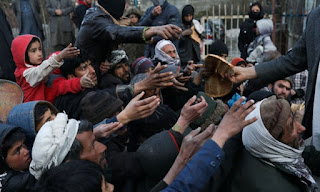Starving Afghans in Need of Help
By Naveed Qazi | Editor, Globe Upfront
Afghanistan has plunged into a middle of a ravaging famine, after a severe drought. Unlike past humanitarian crises in Afghanistan, that received credible worldwide attention, this one has not, amid a nose diving revenue. A country which is left to drug trade, with opium as the only cash crop, and having an addiction to remittances, a question arises: are Taliban fit to govern? They are actually denying the scale of the famine.
The question of their competence in pacifying the crises comes at a time when common Afghans are selling their children and kidneys for survival. Infact, the unregulated kidney selling practice has already nicknamed a nearby settlement in Herat as ‘one kidney village’. Some are willing to sell their kidney for as little as fifteen hundred US dollars to brokers, who have wealthy patients by their side. The irony is that even after selling a kidney, they still are trapped in poverty, as the money received would not allow them to hold on for long.
The ones who are surviving in this tsunami of hunger are just managing to have some bread and water. Many of them do not have enough clothes or heating to keep themselves warm during winter. By not keeping the cold away, they are dying of pneumonia, and other chronic illnesses. Ones who manage to travel to hospitals, from very remote areas, are bereft of hospital care because the hospital spaces are overwhelmed. There are others who manage loans for checkups from their relatives when treatment becomes available. As many hospitals in Afghanistan are low on oxygen cylinders, it deprives them of a quality healthcare. According to Save The Children report, almost sixty percent of those who couldn’t get healthcare said they had no money to pay for it.
There are also many remote places, which are not accessible for emergency workers. For these volunteers, who are working in clinics, their goals are getting life saving food, and mandatory health care assistance. According to New Zealand Herald, some of these workers haven’t seen common Afghans suffering like this since a very long time.
'The situation here now is absolutely desperate for the entire population, but especially for young children,' said Fiona McSheehy, Save the Children’s Acting Country Director, to France 24 from Kabul. 'The rising number of cases of pneumonia is frightening and all the more so because it is directly linked to high levels malnutrition.'
UNICEF estimates that half the children under the age of five years old will be acutely malnourished in Afghanistan in 2022, due to the food crisis coupled with poor access to water, sanitation and hygiene services. They also believe that over ninety seven percent of Afghanistan’s population is expected to be under the poverty line in 2022.
Although, there is one positive twist in the Afghan story, which is that some relief workers are able to go into districts that they haven’t been able to access for twenty years because they were in the Red Zone during war.
World Food Programme (WFP) had announced in January 2022 that it needs urgent funding of USD 2.6 billion to boost operations for 8.7 million starving Afghans as freezing winters always deteriorate the situation. WFP's chief of communications, according to Khaama Press, also expressed concern about electricity blackout in Afghanistan.
There is no denying of the fact that Afghanistan is one of the poorest countries in Asia, and that fifty years of guerilla warfare has made it even more poorer. With no industry, the situation speaks for itself.
As central bank is in Taliban’s hand, anti-terrorism legislation enables countries like the US to deny the country access even to the many billions of dollars (mostly unspent aid money, but also private savings) that the former government had on deposit with foreign banks.
There are around seven billion dollars of Afghan money frozen in US banks. Infact, on February 11, 2022, Biden signed an executive order splitting this frozen money evenly between US victims of terrorism and humanitarian aid to the Afghan people, showing an injustice of sorts. However, according to Financial Times editorial board, an idea by Gordon Brown, the former UK prime minister, for pledging a conference among nations to face this adversity should be taken seriously. But, what is unfortunate is that a plea from UN to pledge 4.4 billion US dollars in Afghanistan has been largely ignored, despite UK and US giving some limited humanitarian carve outs to sanctions.
The UN had even called on the World Bank to unfreeze 1.2 billion US dollars in development funding to the country. This amount is far less than the annual amount Afghanistan was previously receiving under World Bank’s special trust fund. Nevertheless, it would be vital in paying public sector workers, especially health workers in Afghanistan. Paying these wages would also bypass the Taliban. There are other examples in the world such as Yemen and Somalia, where the UN agencies have paid public sector employees through intermediaries.
For common Afghans, some good news also came in February 2022, when India and Pakistan supplied fifty thousand metric tonnes of wheat to Afghanistan. The stock was dispatched from Attari near Wagah border, and was set to be distributed by World Food Programme. However, this is just a start, and Afghans need more than this.




Comments
Post a Comment
Advice from the Editor: Please refrain from slander, defamation or any kind of libel in the comments section.